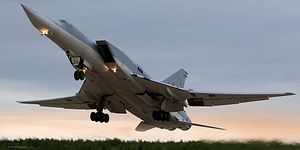A Russian Air Force Tupolev Tu-22M3 supersonic bomber crashed at Olenegorsk airbase, in Russia’s northwestern region of Murmansk on January 22, killing three crew members; one survived. It was not immediately clear what caused the aircraft to crash. According to Russian law enforcement officials, cited by TASS news agency, bad weather conditions in combination with a pilot error are likely to blame.
The Russian Ministry of Defense (MoD) said in a public statement that the Tu-22M3 mission was carried out without weapons. The Tu-22M3 was reportedly returning after completing a training or other flight with another Tu-22M3 over the Arctic region. According to law enforcement officials, the Russian Air Force’s fleet of Tu-22M3 will remain grounded pending the results of an official inquiry into the causes of the accident.
The January 22 incident constitutes the second accident involving Russian military aircraft this month. On January 18, a pair of Su-34 fighter-bombers crashed into the Sea of Japan after reportedly colliding with each other off the coast in Russia’s Far East. The aircraft were unarmed and flying in close formation. One of the four crew members aboard the two aircraft was recovered alive.
The Tu-22M3 is a derivative of the Tu-22 supersonic variable-sweep wing fighter-bomber first introduced into service with the Soviet Air Force and Soviet Naval Aviation in the 1970s. There are currently around 60 Tu-M3s in service with Russian military aviation, although the serviceability rate of the fleet is thought to be under 50 percent. About half of the Tu-22M3 are expected to be upgraded to the more advanced Tu-22M3M variant.
“In comparison to its immediate predecessor the Tu-22M3, the modernized Tu-22M3M will feature upgraded avionics, new digital radio-navigation equipment, and a new communications suite, next to a number of other improvements,” I explained previously. “Notably, unlike the upgraded Tu-160M2 long-range strategic bomber, the Tu-22M3M will not be fitted with a new engine.”
The maiden flight of the first upgraded Tu-22M3M took place on December 28. As I explained, the Tu-22M3M will be capable of firing Kh-32 long-range cruise missiles:
The Kh-32, an upgraded version of the Raguda Kh-22 long-range anti-ship missile, has been specifically designed to attack U.S. Navy carrier strike groups, but can also be used for land strike missions. It is reportedly designed to climb to the stratosphere (40 kilometers) after launch and then either directly dives at the target or executes a lighter dive and approaches the target flying close to the ground at around 150-200 meters. The K-32 purportedly has an operational range of 1,000 kilometers and can reach top speeds of over Mach 4 in its terminal phase.
The Tu-22M3M can also carry the Rhaduga Kh-15 aero-ballistic missile. The bomber will be capable of carrying up to three Kh-32 or 12 Kh-15 missiles. Both the Kh-15 and Kh-32 can alternatively be fitted with conventional or nuclear warheads.
Overall, the bomber can carry a weapons load of around 24 tons.
The Tu-22M3M is expected to enter service with the Russian Air Force by 2021.
































